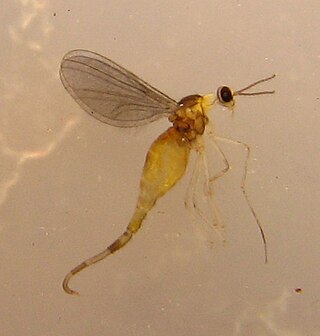
The Cecidomyiinae, commonly known as gall midges or gall gnats, is the largest subfamily in Cecidomyiidae with over 600 genera and more than 5000 described species. This subfamily is best known for its members that induce galls on plants, but there are also many species that are fungivores, parasitoids, or predators as maggots.
Polystepha is a genus of gall midges in the family Cecidomyiidae. There are more than 20 described species in Polystepha.
Resseliella is a genus of gall midges in the family Cecidomyiidae. There are at least 50 described species in Resseliella.
Monardia is a genus of wood midges, insects in the family Cecidomyiidae. The 53 described species in Monardia are grouped into three subgenera.
Micromyinae is a subfamily of wood midges, insects in the family Cecidomyiidae. Its members were formerly included in subfamily Lestremiinae. There are at least 55 genera and more than 650 described species in Micromyinae. All species in this subfamily are mycophageous.
Haplusia is a genus of gall midges and wood midges in the family Cecidomyiidae. There are more than 20 described species in Haplusia.

Winnertziinae is a subfamily of gall midges and wood midges in the family Cecidomyiidae.

Winnertzia is a genus of gall midges and wood midges in the family Cecidomyiidae. There are more than 90 described species in Winnertzia.
Porricondylinae is a subfamily of gall midges and wood midges in the family Cecidomyiidae.
Lestremiinae is a subfamily of Cecidomyiidae. It is composed of 105 described species classified into 13 genera. The larvae feed on fungi, primarily in rotting wood.
Allarete is a genus of midges in the family Cecidomyiidae. There are twelve described species in this genus. It is known from the holarctic, afrotropical, and oriental regions. The genus was first described by Arthur Earl Pritchard in 1951.
Conarete is a genus of midges in the family Cecidomyiidae. There are 13 described species in this genus. It was established by Arthur Earl Pritchard in 1951.
Bryomyia is a genus of midges in the family Cecidomyiidae. The six described species are found in the Holarctic and Oriental regions. The genus was first described by Jean-Jacques Kieffer in 1895.
Campylomyza is a genus of midges in the family Cecidomyiidae. The 40 described species are found in the Holarctic, Oriental, Neotropical, and Australasian regions. The genus was first described by German entomologist Johann Wilhelm Meigen in 1818.
Catocha is a genus of wood midges in the family Cecidomyiidae. There are eight described species. The genus was established in 1833 by Irish entomologist Alexander Henry Haliday.
Heterogenella is a genus of wood midges in the family Cecidomyiidae. The twelve described species are found in the Holarctic and Oriental realms. The genus was established by Boris Mamaev in 1963.
Neurolyga is a genus of wood midges, insects in the family Cecidomyiidae. The 28 described species occur in the holarctic region. The genus was established by Italian entomologist Camillo Rondani in 1840.
Polyardis is a genus of midges in the family Cecidomyiidae. The ten described species are found in the Holarctic and Australasian realms. The genus was first described by entomologist Arthur Earl Pritchard in 1947.

